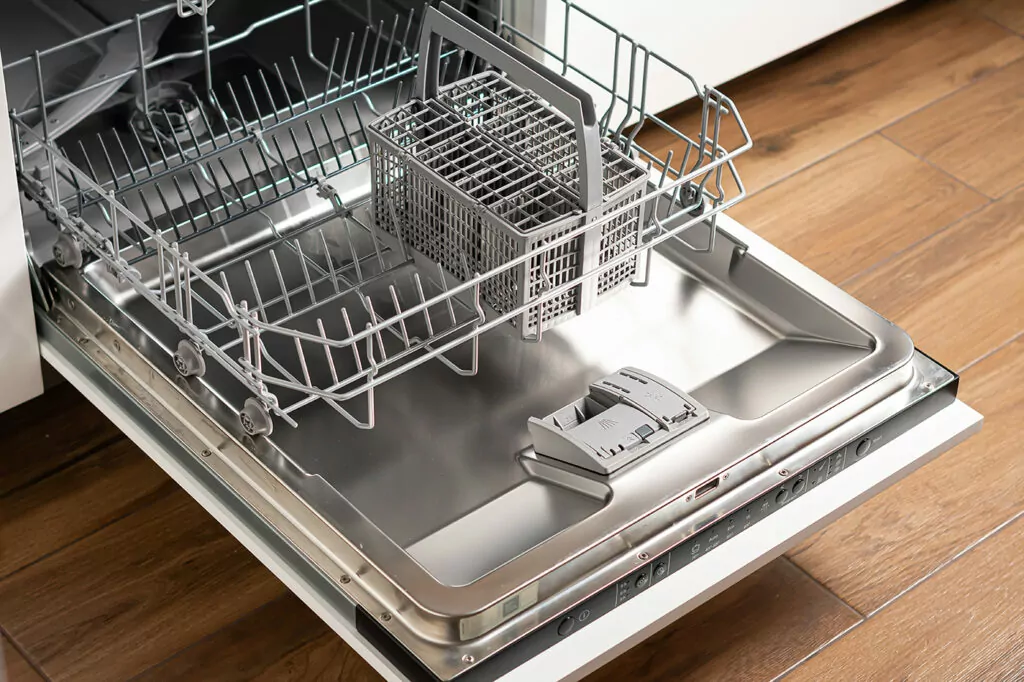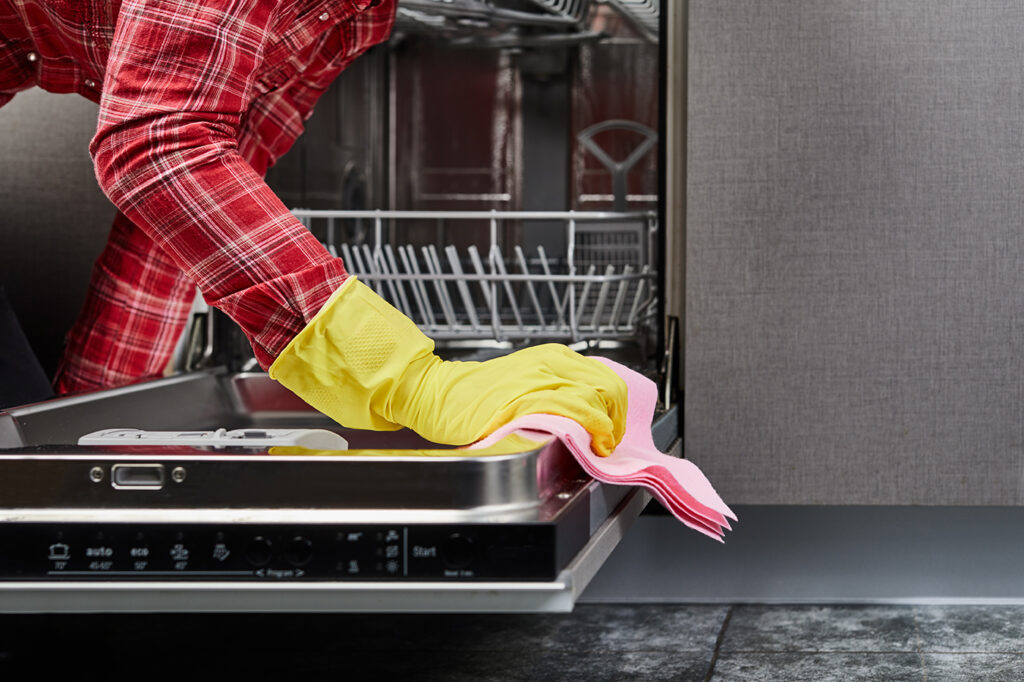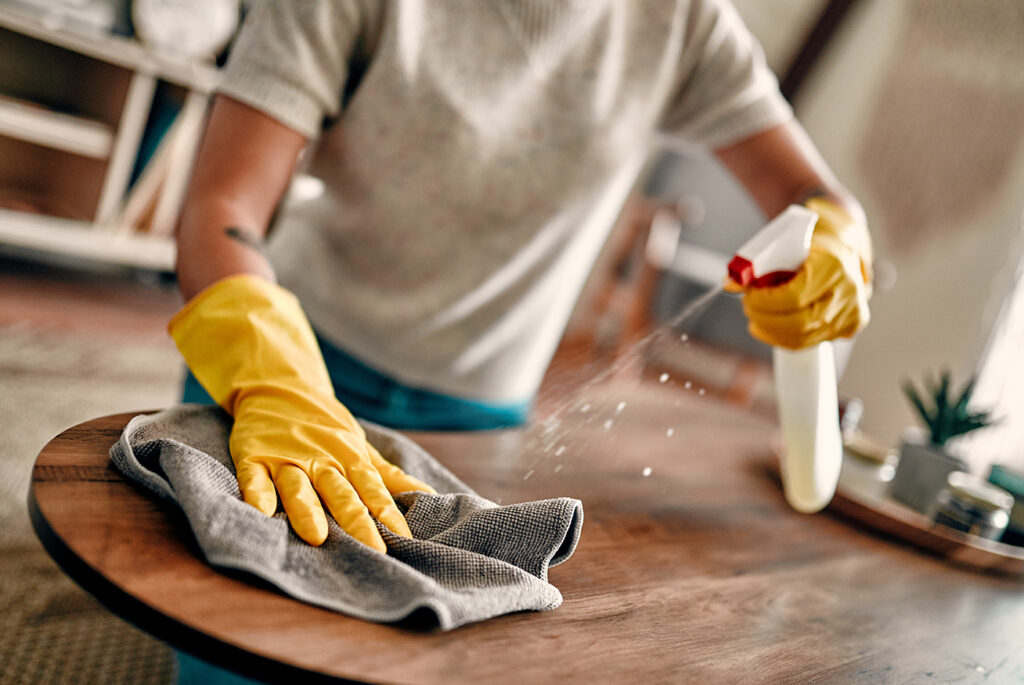We understand–cleaning your dishwasher is the last thing on your mind. After all, why clean something designed to clean other things? However, if you’ve started to notice subpar results when unloading, it’s time for a thorough cleaning. Beyond leaving dishes dirty, a dirty dishwasher can lead to unpleasant odors, drainage problems, and a buildup of grease and grime. Don’t let this kitchen essential fall by the wayside. Keep reading for a step-by-step guide on how to deep clean your dishwasher.
How Often Should I Clean My Dishwasher?
Maintaining a clean dishwasher is a task that should be tackled daily, weekly, and monthly. On a daily basis, make it a habit to remove any visible food from the bottom and inside the dishwasher filter. Weekly, take the time to wipe down the door, edges, and seal, and don’t forget to remove and clean the filter. Every month, perform a deep clean with an interior cycle–it’s easier than you might think (more details below)! Additionally, remember to clean or scrub the interior components as needed. All of this is assuming you use your dishwasher around once a day.
Project Overview
Fortunately, deep cleaning a dishwasher is a straightforward, budget-friendly, and time-efficient project. To get started, you just need 15 to 30 minutes, $5 to $10 for supplies, and a beginner’s skill level.
Supplies Needed

Below is a breakdown of what you’ll need:
Materials
- Distilled white vinegar
- Baking soda
- Dish soap
- Stainless steel cleaning product
- Olive oil or baby oil (specifically for stainless steel)
- Dishwasher cleaner (optional)
Tools
- Soft-bristle brush
- Flexible wire
- Old toothbrush
- Sponge
- Microfiber cloths
How Do You Deep Clean and Deodorize a Dishwasher?
Now that you have everything you need, let’s dive into how to deep clean and deodorize your dishwasher step-by-step.
1. Remove the Utensil Holders and Dishwasher Racks

The first step in cleaning a dishwasher is to remove the utensil holder and dishwasher racks. You can place them in the sink or, if your sink is too small, in the bathtub. Wipe off any foodstuff, or place them in a mixture of warm water—approximately half of your sink or tub—and one cup of white distilled vinegar. Allow them to soak for 30 minutes.
2. Clean the Filter and Drain

While the racks are soaking, clean the dishwasher’s filter and drain—two essential components in the deep cleaning process ensuring optimal functionality. Unless your dishwasher features a self-cleaning filter (consult your dishwasher manual, available online if you don’t have a hard copy), it will likely have two filters. The first is a screen that captures food, while the second sits in the bottom. Remove both filters and wash them in the sink using soap and water.
3. Clean the Dishwasher Arms

Next, clean the dishwasher seal and arms. Cleaning the seal is simple; just use a scrub brush. Then, inspect the small holes in the dishwasher arms, as food can sometimes become stuck. Take a flexible wire or toothpick and insert it into each hole to remove any debris.
4. Add Vinegar or Baking Soda in the Dishwasher

Now, for the straightforward part! Simply replace the filters and bottom rack. Next, fill a dishwasher-safe container with one cup of white vinegar. Set the dishwasher to run on a hot water cycle, turning off the drying mode. Once the cycle is complete, sprinkle one cup of baking soda at the bottom of the dishwasher, and again, run a hot water cycle without the drying option.
5. Clean the Outer Door

Finally, clean the door of the dishwasher with a microfiber cloth and a solution of dish soap and water, following the material’s grain. You can follow up this step with a drop of baby oil or olive oil on a microfiber cloth to remove any streaks.
Tasker’s Tips to Clean a Dishwasher

Want some tips? Take advice from seasoned Taskers for more on cleaning a dishwasher:
- Run the garbage disposal: Always run the garbage disposal before starting the dishwasher. Since dishwashers often share a drainage pipe with the sink, a clear pipe ensures optimal dishwasher efficiency.
- Prime with hot water: Run hot water in the sink before starting the dishwasher to guarantee the appliance begins its cycle with hot water. This promotes better cleaning results.
- Rinse plates lightly: Before loading, give your plates a quick rinse to remove excess food. Additionally, avoid overloading the dishwasher to ensure it operates at its peak efficiency.
- Infuse freshness: Upgrade your dishwasher’s scent by placing orange or lemon peels in the utensil holder. Run a hot water load to enjoy a burst of fresh, citrusy fragrance.
Cleaning a Dishwasher FAQs

Can I Run a Dishwasher Empty to Clean It?
Running a dishwasher empty does not clean away detergent, mineral, and food particle buildup. To address this, run the dishwasher on an empty cycle with a dishwasher cleaner specifically designed to break down and eliminate such buildup.
Can Dishwashers Be Cleaned With Bleach?
It is not advised to clean a dishwasher with bleach, as bleach can damage stainless steel parts.
Find a Tasker’s Help!
All in all, regular dishwasher cleaning maintenance is necessary for clean dishes and an overall functioning dishwasher. Plus, maintaining your dishwasher ensures it stays top-notch for years to come. Don’t shoulder the job by yourself! Reach out to a Tasker for all your deep cleaning needs, and enjoy the benefits of a sparkling clean and well-maintained dishwasher.














